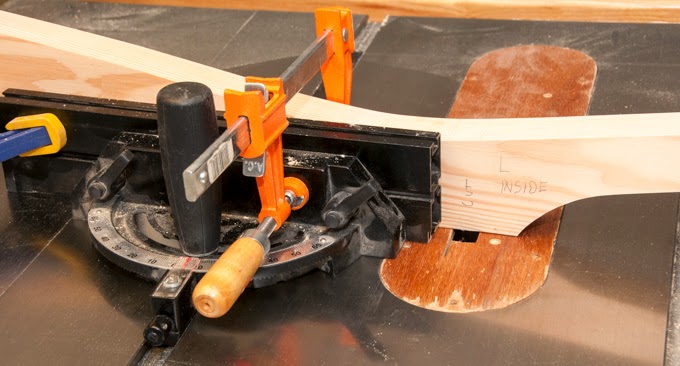With a basic processes needed to build the seat and legs
practiced plus a couple pages of notes on things to do and not do I started on
the real seat. I made the notes as I
built the mock-up to make sure I did not miss anything and because it’s pretty
easy to get something out of sequence.
First order of business is to check to see if any of the
seat’s rough cut pieces had moved since they were cut. Well, three of the five had developed a bit
of a twist that had to be flattened so I dragged out hand plane and set to work
truing up the surfaces. Not hard but it
took half a day to get them all square, flat and to a thickness that varied
less than 1/100 of an inch. I needed the
outside boards of the seat to be this accurate because the leg joints are cut from
the top and bottom and what remains is the tenon of the leg joint. If the board thickness varies so does the
thickness of the tenon. The mating
piece is cut with a dado blade and does not vary once set. End result is if the boards are different thickness
then some joints will fit and some won’t.
The fix to make them go together is to modify each joint by hand. With all the angles and arcs I really, really
want to keep that to a minimum.
Once I had all the pieces ready to go I laid them out shuffling
the order, flipping end to end, switching top and bottom and shifting back and
forth until I got a good grain match.
The photo shows the final result.
Once the pieces are cut to width with proper bevels I will cut them to
final length.
 |
| Grain Matched |
This process for putting the seat blank is nearly the same
as the mock-up so I will not go into a lot of detail here. First is to mark the
bevel direction then set the blade on the table saw and cut the edges on each
board.
 |
| Direction of Cut Marked |
 |
| Angles Cut |
 |
| Still Flat |
With the blank at final
width I clamped the seat template to the blank then traced the seat outline and
the guide line for the recessed area.
More layout followed: the dowel locations, the front leg dado then the
back leg straight and angled geometry. Unfortunately these layout lines are made with a sharp pencil resulting
in thin lines that just did not show up in the photograph.
 |
| Seat Layout Done |
One change from the mock-up was the way I marked the dowels
location. In the mock-up I measured each
one with the calipers. This time I set a
couple of combination squares and used them to do the layout. If you carefully look just about 3/4 an inch off the end of the squares in the photograph you can just see a small point marking where the dowel will go.
 |
| Combination Squares Set for Marking Dowels |
A dry fit and clamp with the dowels in place
showed the outer boards still flat. Not that I am paranoid about things getting out out of alignment or anything.
 |
| Still Flat? - Yep |
 |
| Rear Leg Joint with Just a Smidge to Remove |
When I did the mock-up I had some problems with getting a smooth
transition between the straight and angled router bits. I felt like I needed more practice with the
bits to avoid the gap problem in the actual chair. Digging in the scrap box turned up some 2x6
material so while I had the saw set up I made four test pieces to practice the
rear leg joint.
Next Up – The Real Seat: Fitting Legs & Seat Glue-up






























